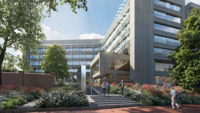The American Institute of Architects (AIA) is about to start walking the talk. Already garrulous on matters of sustainability, its leadership is evaluating a range of options for greening its headquarters in Washington, D.C. “We want to make our headquarters a demonstration project,” says RK Stewart, FAIA, the AIA’s president. “We have the opportunity to provide a great place for people to work and for our members to visit, and an opportunity to reach out and show the public what’s possible.”


Designed by The Architects’ Collaborative, the Walter Gropius—led design firm based in Cambridge, Massachusetts, the 180,000-square-foot building has not seen significant renovations since it opened in 1973. The AIA occupies two floors, while related architecture associations and a law firm rent the remaining five levels. But the AIA’s office needs have changed over the years and this, coupled with the institute’s focus on sustainability as part of its 150th anniversary celebrations, prompted it to begin thinking about the building’s future. It hired Quinn Evans Architects to study its needs and suggest alternatives for updating the structure in a sensitive, green way.
“This is a future landmark building,” observes Carl Elefante, AIA, a principal with Quinn Evans’ D.C. office. “What we do now is going to affect its condition when it turns 50 and becomes eligible to be designated a landmark, so we should be thinking of that stewardship today.”
The AIA is currently evaluating Elefante’s recommendations. Stewart says that although it’s far from making any firm decisions, the AIA is considering everything from installing rainwater collection and graywater recycling systems, which would reduce water use, to adding wind turbines and photovoltaic cells on the roof, to generate power. “Everything is on the table,” Stewart says. “We want to figure out how to demonstrate what really works for members and the public, and also be good stewards of the building at the same time as being stewards of the planet.” He adds that the AIA hopes to finalize a design by the end of this year, but beyond that he is unable to lay out a construction timetable or budget.
The AIA built its headquarters during a 1970s effort to rejuvenate The Octagon House, its former home nearby. Dating to 1800, this William Thornton–designed building now houses the American Architectural Foundation.


